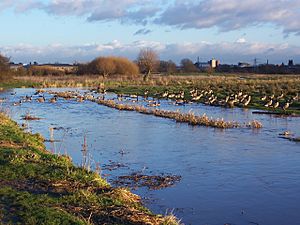Doxey Marshes facts for kids
Quick facts for kids Doxey Marshes |
|
|---|---|

Doxey Marshes in October 2006
|
|
| Type | Nature reserve |
| Location | Stafford, England |
| OS grid | SJ903250 |
| Area | 150 hectares (370 acres) |
| Operated by | Staffordshire Wildlife Trust |
| Status | Site of Special Scientific Interest |
Doxey Marshes is a special place near Stafford, England. It's a huge nature reserve, about 150 hectares (that's like 370 football fields!). The Staffordshire Wildlife Trust looks after it. This area is super important because it's a "Site of Special Scientific Interest." This means it has rare wet grassland and is home to many amazing birds and animals. You might spot snipe, lapwing, little ringed plover, otters, and even tiny water shrews here.
Doxey Marshes is next to the River Sow. Sometimes, the river overflows and floods the marshes. This flooding is actually great for wading birds! It leaves behind shallow pools and muddy areas where they can find lots of food. In spring and autumn, when birds are migrating, Doxey Marshes attracts many different kinds of birds. Some rare visitors have included the river warbler, marsh warbler, purple heron, and European bee-eater.
If you enjoy fishing, you can get a permit for Doxey Marshes Nature Reserve from the Staffordshire Wildlife Trust.
Contents
Looking After Doxey Marshes
The Staffordshire Wildlife Trust manages Doxey Marshes Nature Reserve. They use special methods to keep this important habitat healthy for all the wildlife.
Cattle Grazing
One way they manage the land is by letting cattle graze during the summer. This is a very old way of looking after wet grasslands. The cattle eat the grass, keeping it short. This helps ground-nesting birds, like lapwings, to see predators easily. The Trust carefully watches the number of cattle to make sure they don't accidentally step on eggs or nests.
Cutting Rushes
There are also large areas of rushes at Doxey Marshes. Cattle don't like to eat these plants. So, people cut the rushes by hand in certain spots. This creates open areas where birds can feed and also provides some places for them to hide.
Pollarding Willow Trees
Another important job is "pollarding" the willow trees. This is an ancient way of pruning trees that helps them live longer. The branches are cut off above the height where cattle can reach them. This also stops birds like crows and magpies from perching high up and preying on young chicks and eggs. These old pollarded willows become homes for other creatures too. Musk beetles live in the rotting wood, noctule bats find homes in the cracks, and otters sometimes hide in the thick branches during the day.
Images for kids







